The Weeping Fig Bonsai is a visually stunning plant that will enhance the aesthetic appeal of any indoor space. Its slender branches gracefully arch from a light gray trunk, creating an elegant and captivating silhouette. The real showstopper, however, is the glossy dark leaves that adorn the branches.
Appearance of Weeping Fig Bonsai

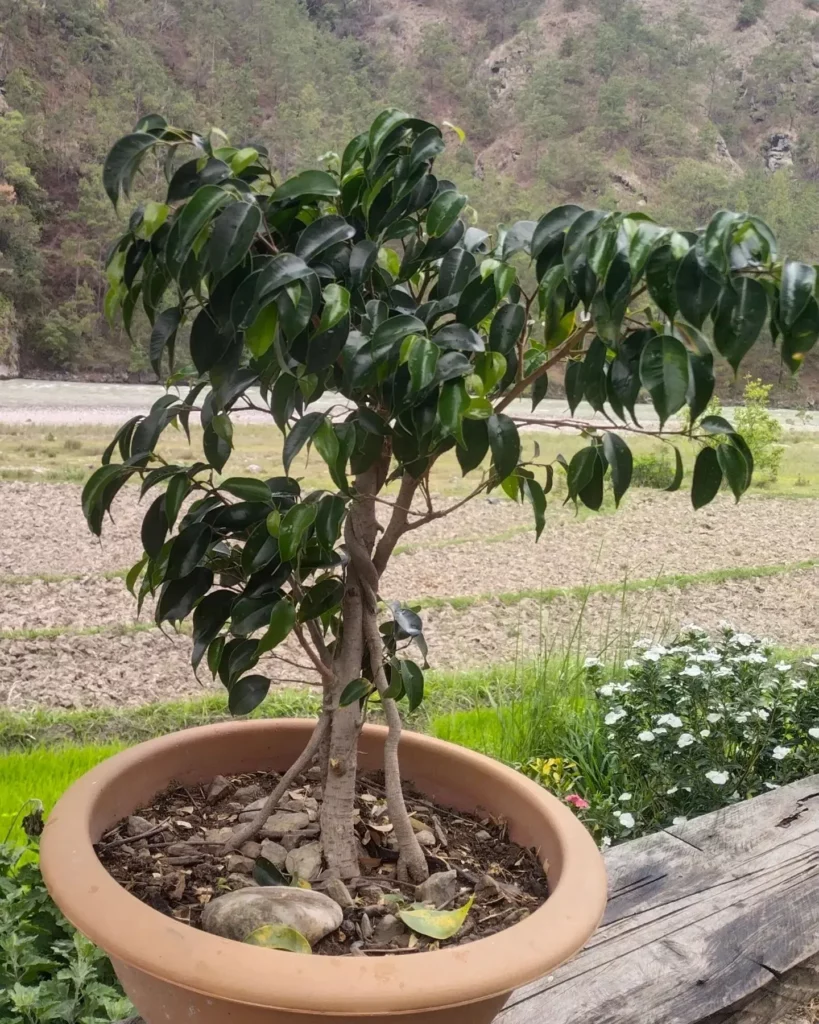
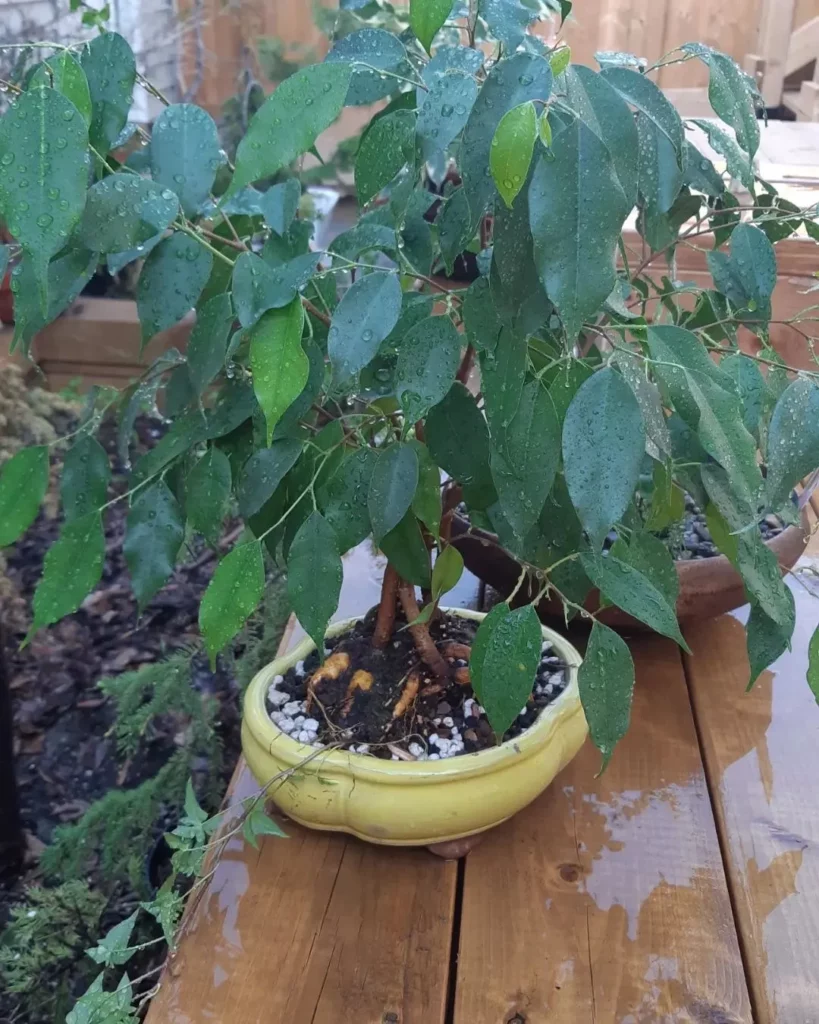
The Weeping Fig Bonsai Plant lush and vibrant leaves provide a beautiful contrast against the light gray trunk and create a sense of depth and texture. Their glossy sheen adds an element of sophistication and elegance to the overall appearance of the Weeping Fig Bonsai.
The dense foliage of the Weeping Fig Bonsai forms a lovely backdrop for the tree’s graceful shape. It fills out the branches, creating a full and lush look. This makes the Weeping Fig Bonsai an ideal choice for those seeking a plant that exudes natural beauty and serenity.
With its slender branches and glossy dark leaves, the Weeping Fig Bonsai is a true testament to the artistry of nature. Whether placed in a living room, office, or any other indoor setting, it is sure to captivate and delight with its striking appearance.
No products found.
Light Requirements for Weeping Fig Bonsai
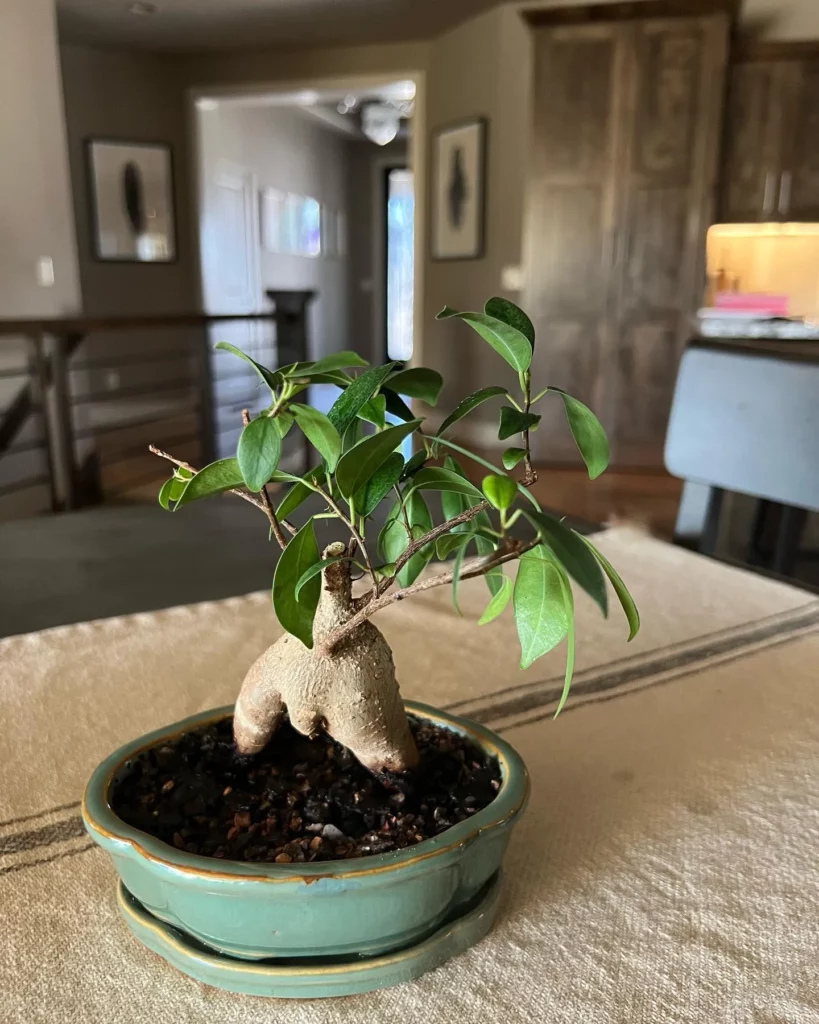
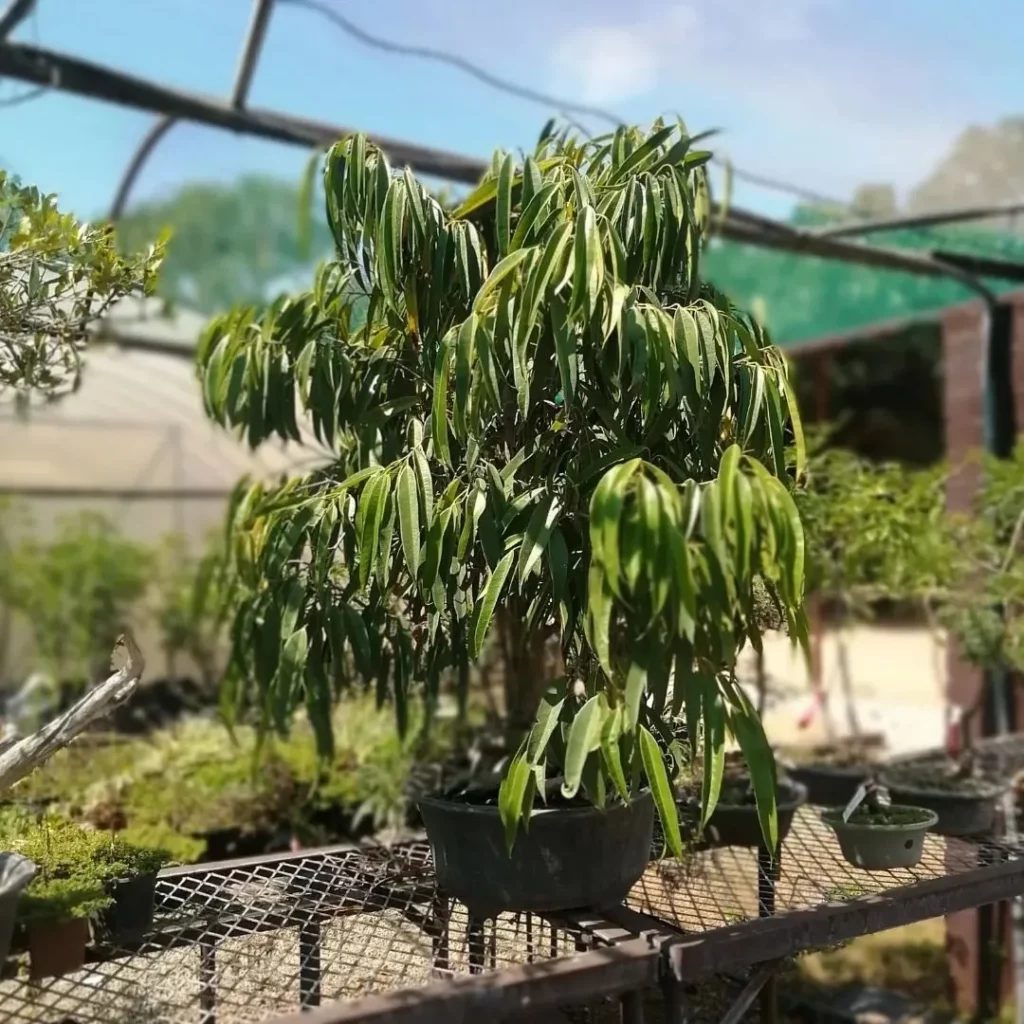
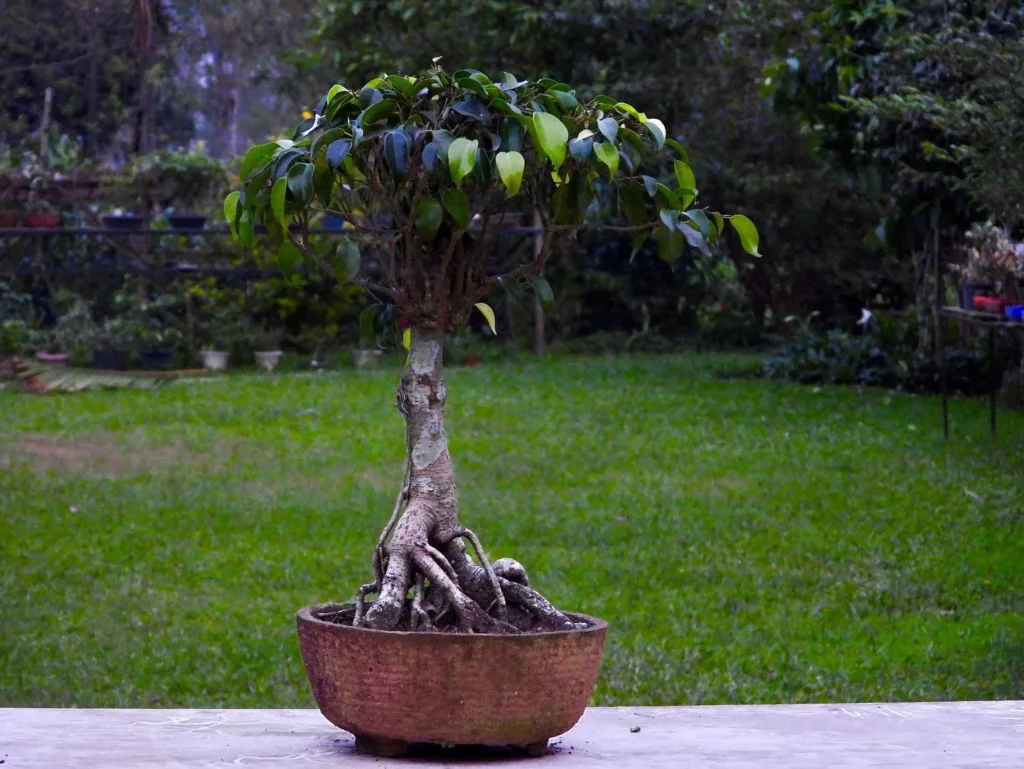
Weeping Fig Bonsai, a popular indoor plant, thrives in bright indirect light. To ensure its optimal growth and health, it is important to provide the right light conditions. Here are the key light requirements for Weeping Fig Bonsai:
- Bright Indirect Light: Place your Weeping Fig Bonsai in a room that receives plenty of natural light. However, make sure to avoid direct sunlight as it can scorch the leaves. Weeping Fig Bonsai is native to semi-shady conditions, so finding a spot with bright indirect light will help it thrive.
- Avoid Frequent Movement: Once you have found the ideal spot for your Weeping Fig Bonsai, try to avoid moving it frequently. Sudden changes in lighting can cause stress to the plant, leading to leaf drop. Find a stable location where it can receive consistent bright indirect light.
Watering Weeping Fig Bonsai

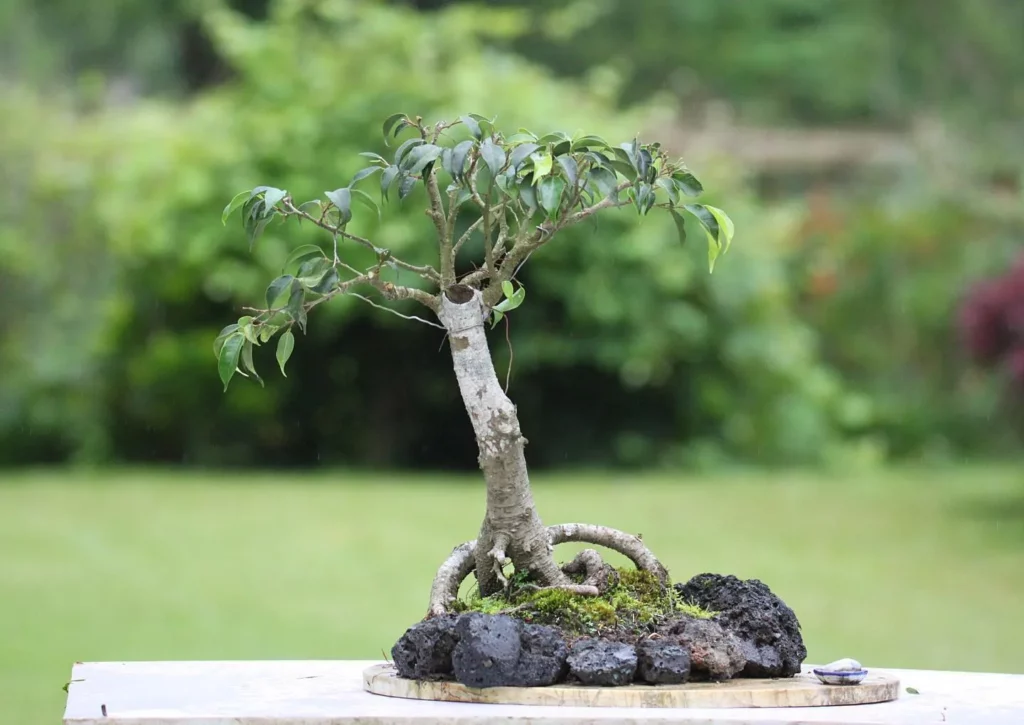
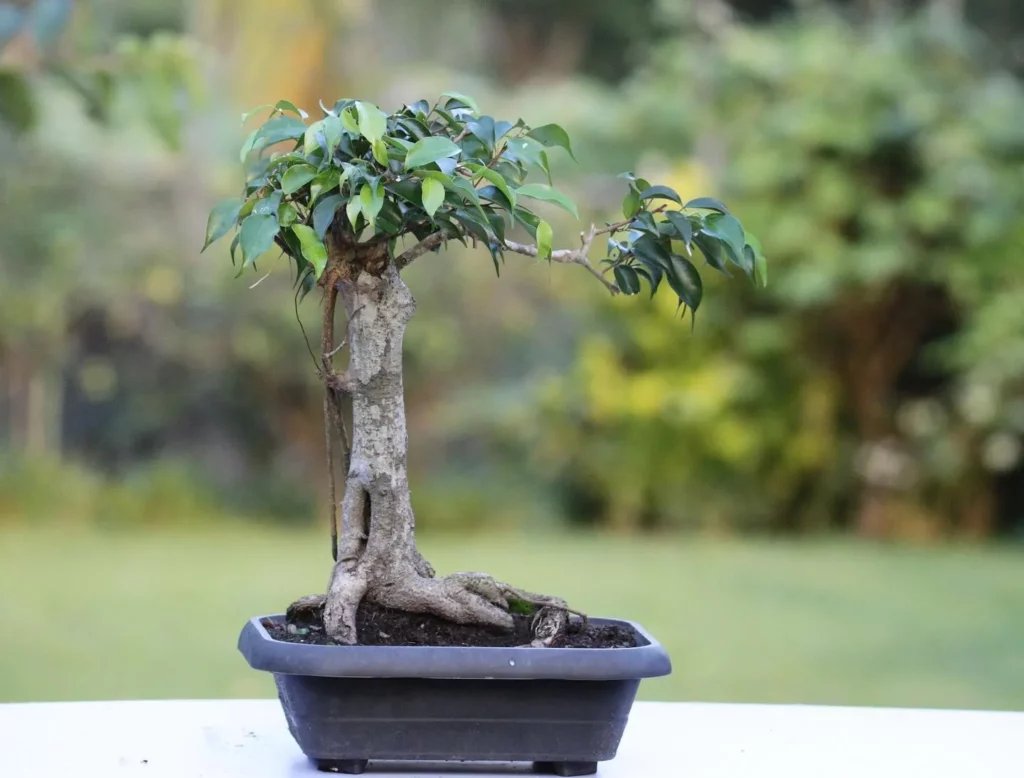
Weeping Fig Bonsai, also known as Ficus benjamina, requires consistent moisture in its soil to thrive. However, it’s important to avoid overwatering, as this can lead to root rot and leaf drop. To ensure proper watering, it’s essential to establish a consistent watering schedule.
During the growing season, which typically spans spring and summer, the Weeping Fig Bonsai should be watered more frequently. Monitor the moisture level of the soil and water when the top inch feels slightly dry. Use your finger or a moisture meter to check the soil’s moisture content.
As fall and winter approach, reduce the frequency of watering. Allow the soil to dry out slightly between waterings to prevent waterlogging. Be mindful of the plant’s water needs during this dormant period, as water requirements tend to decrease.
When watering your Weeping Fig Bonsai, aim for a thorough yet gentle watering. Ensure that the water is evenly distributed throughout the pot, providing ample moisture to the roots. Avoid letting the plant sit in standing water, as this can lead to root suffocation and other issues.
To help maintain an optimal moisture level, consider using a well-draining soil mix specifically formulated for bonsai plants. This type of soil mix allows for proper water absorption and drainage, reducing the risk of waterlogged roots.
- Water thoroughly, but avoid overwatering.
- Establish a consistent watering schedule based on the plant’s needs.
- Monitor soil moisture to determine when to water.
- Use well-draining bonsai soil mix for optimal moisture control.
- Prevent waterlogging by ensuring proper drainage.
Fertilizing Weeping Fig Bonsai
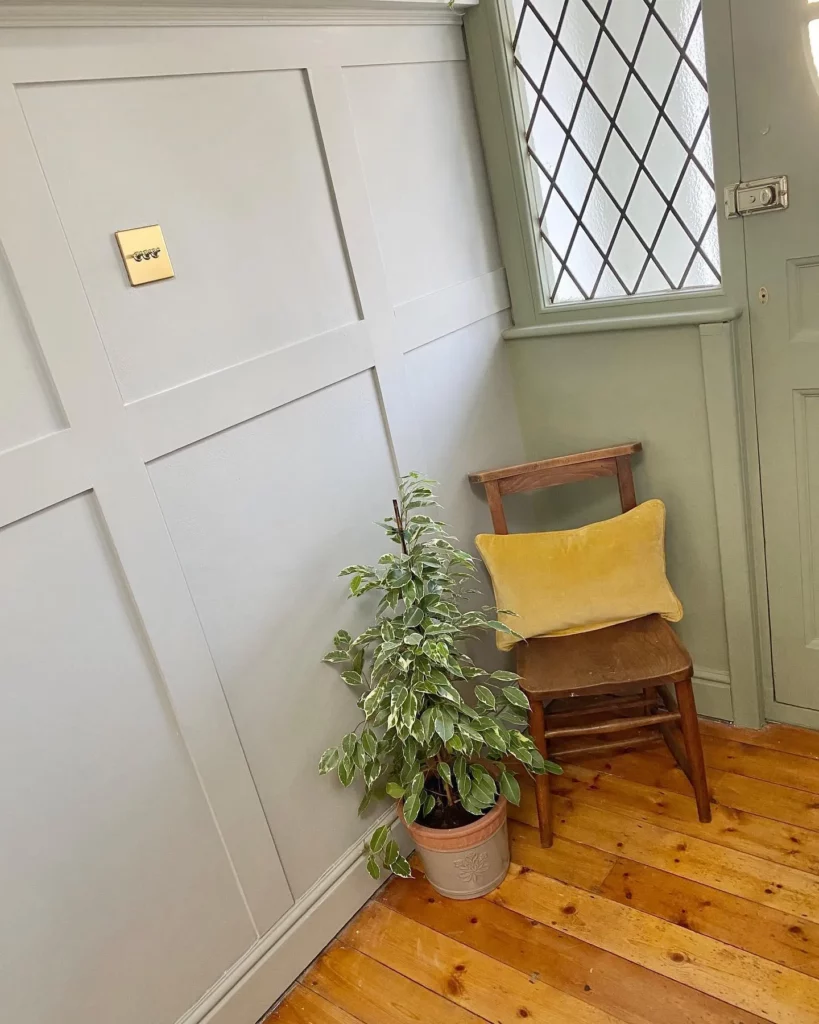
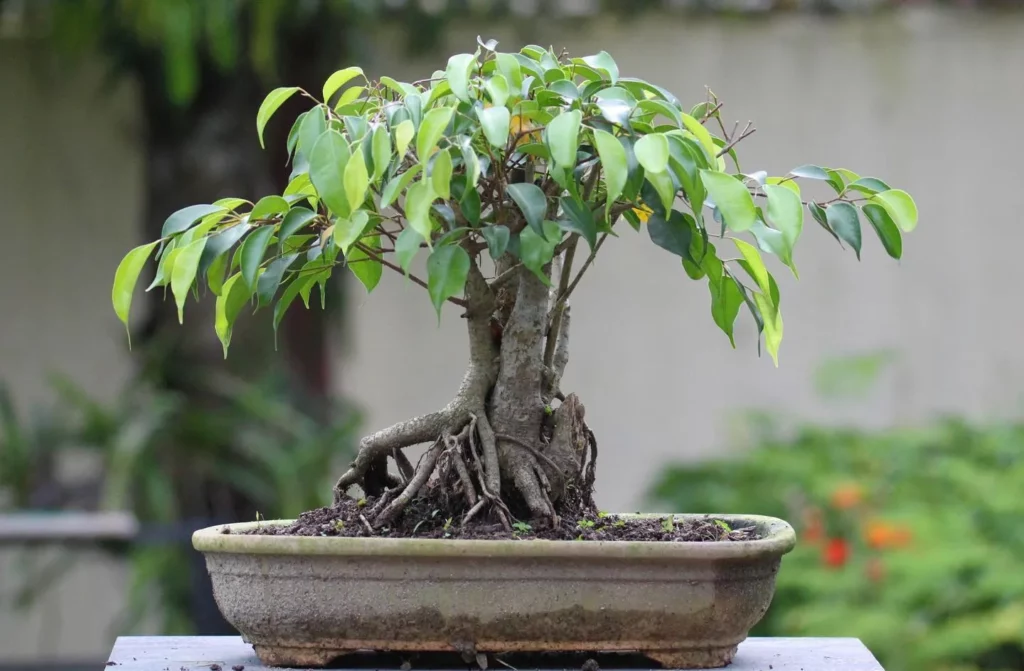
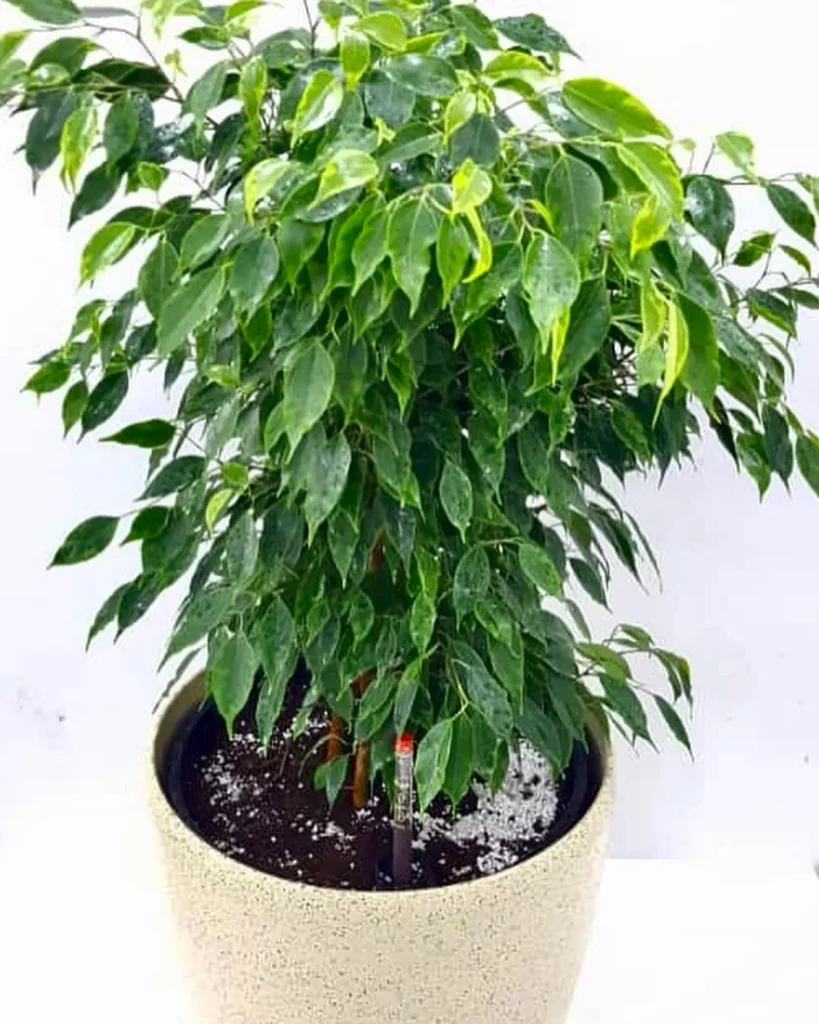
Weeping Fig Bonsai is a rapid grower and requires regular feeding to support its growth. It is considered a heavy feeder and benefits from monthly fertilization during the spring and summer months. A balanced fertilizer can be used to provide the necessary nutrients for healthy growth.
Recommended Fertilization Schedule
- Spring and Summer: Fertilize the Weeping Fig Bonsai once a month with a balanced fertilizer. This will ensure the plant receives the necessary nutrients for rapid growth and development.
- Fall and Winter: Reduce the frequency of fertilization to once every two months. This allows the plant to enter a period of dormancy and conserve energy.
During the growing season, slow-release pellets can be used at the beginning to provide a steady supply of nutrients. Additionally, weekly or bi-weekly feedings can be provided with a liquid fertilizer diluted according to the manufacturer’s instructions.
If the Weeping Fig Bonsai is displaying leaf drop despite ideal growing conditions, it may require additional supplements. Magnesium and manganese supplements can help address nutrient deficiencies and promote healthy foliage.
Potting Weeping Fig Bonsai
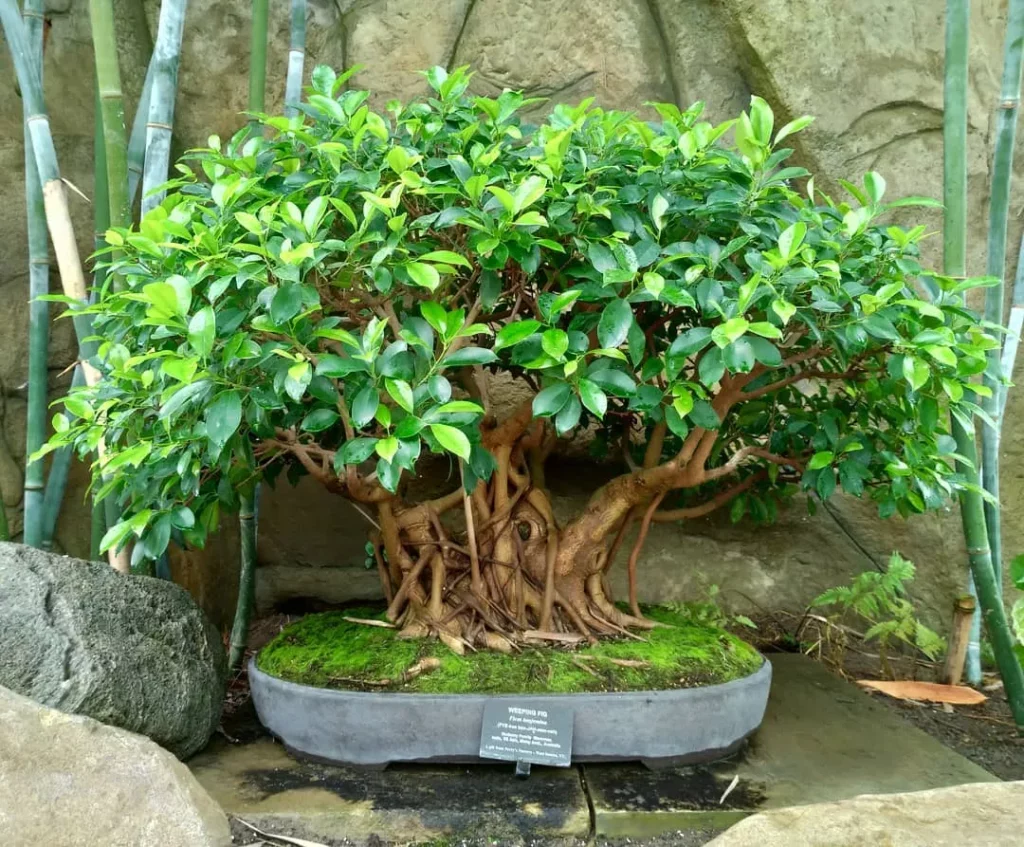
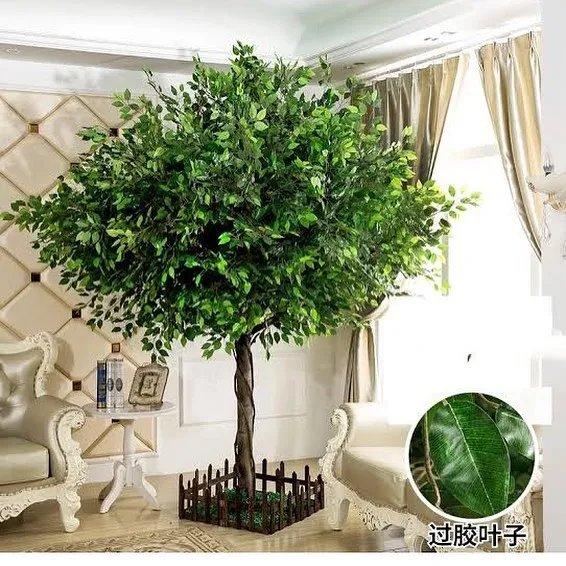
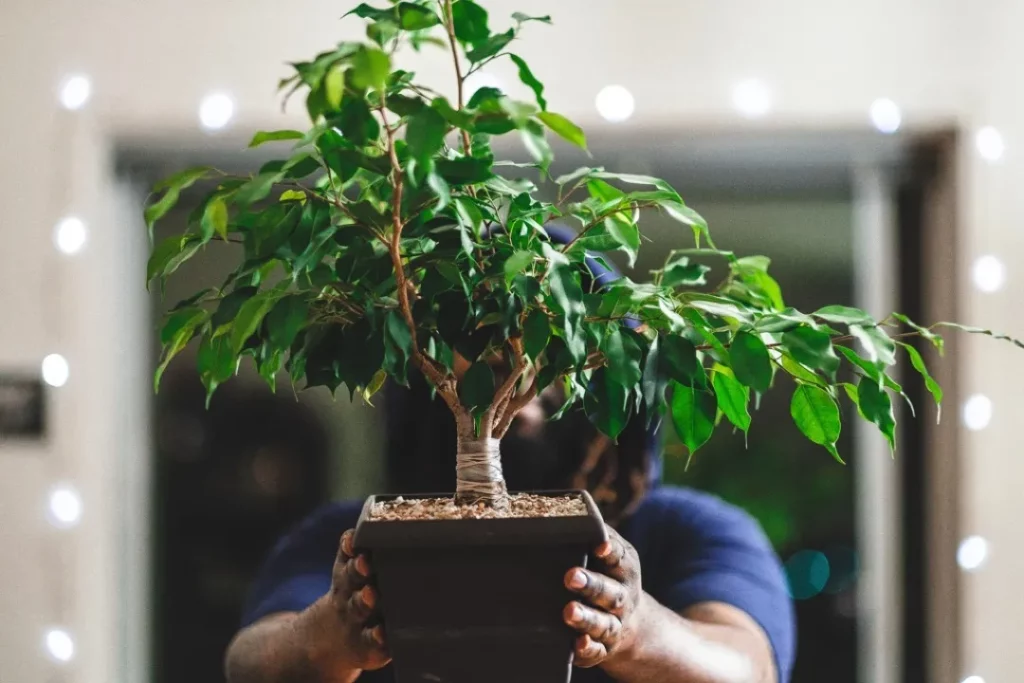
Properly potting your Weeping Fig Bonsai is essential for its growth and overall health. Here are some key considerations to keep in mind:
- Choosing the right pot: Select a pot that provides enough room for root growth and has drainage holes at the bottom. This allows excess water to escape, preventing waterlogging and root rot.
- Using a soil-based potting mix: It’s best to use a soil-based potting mix that is rich and fast-draining. This type of mix provides the necessary nutrients and aeration for your bonsai tree to thrive. Avoid using regular garden soil, as it can retain too much moisture and suffocate the roots.
- Repotting timing: Repot your Weeping Fig Bonsai in the early spring for optimal results. This timing allows the tree to recover and establish its roots before entering the active growth phase of the growing season.
- Repotting frequency: Weeping Fig Bonsai is a fast grower and may need annual repotting. As the tree outgrows its current pot, it may become root-bound, resulting in stunted growth. Regular repotting promotes healthy root development and overall vigor.
Propagation of Weeping Fig Bonsai
If you want to expand your collection of Weeping Fig Bonsai, propagation through cuttings is a simple and effective method. Here’s how you can do it:
- Begin by selecting a healthy branch from the Weeping Fig Bonsai in the spring. Take a cutting that is approximately 3 to 5 inches long and has at least two sets of leaves.
- Remove the lower half of the cutting’s leaves, leaving only the upper leaves intact.
- For enhanced rooting, if desired, treat the cut end of the cutting with a rooting hormone. This will help promote root development.
- Prepare a container by filling it with moistened peat moss. Make sure the container has drainage holes.
- Plant the cutting in the container, ensuring that the cut end is inserted into the peat moss.
- Place the container in a spot with bright, indirect light. Avoid exposing the cutting to direct sunlight.
- To maintain high humidity levels, mist the cutting daily.
- Within two to four weeks, the cutting should develop sufficient roots for acclimation to room conditions.
- After about six weeks, when the cutting has established strong roots, it can be transplanted into a larger pot. With proper care, it will grow into a beautiful Weeping Fig Bonsai.
Growth and Development of Weeping Fig Bonsai
Weeping Fig Bonsai is a fast-growing plant that requires regular attention to its pot and growth. With the right care, it can grow a couple of feet per year, creating a stunning centerpiece in your indoor space. To ensure optimal growth and development, consider the following factors:
1. Watering
- Consistent watering is vital for the growth of your Weeping Fig Bonsai. Keep the soil moist but not waterlogged, as overwatering can lead to root rot.
- During the growing season, water more frequently, and reduce watering slightly in the fall and winter.
2. Pruning
- Regular pruning is necessary to maintain the desired shape and size of your Weeping Fig Bonsai.
- Trim back overgrown branches and remove any dead or yellowing leaves to encourage new growth.
3. Repotting
- As a fast-growing plant, Weeping Fig Bonsai may outgrow its pot quickly, necessitating repotting.
- Repot annually or when the roots become overcrowded. Use a soil-based potting mix that promotes proper drainage.
4. Light and Temperature
- Weeping Fig Bonsai thrives in bright indirect light. Place it near a window where it can receive ample natural light without direct sunlight.
- Maintain a stable temperature range of 60-75°F (15-24°C). Avoid exposing the plant to temperature extremes or drafts.
5. Fertilization
- Weeping Fig Bonsai is a fast-grower that benefits from regular feeding to support its development.
- Use a balanced fertilizer monthly during the growing season and reduce to every two months in the fall and winter.
Pests and Diseases of Weeping Fig Bonsai
Weeping Fig Bonsai, like any other plant, is vulnerable to pests and diseases. Regular inspection is crucial in order to detect any signs of infestation or illness early on. By taking preventive measures and promptly addressing any issues, you can ensure the health and longevity of your Weeping Fig Bonsai.
Pests
Weeping Fig Bonsai can fall prey to common pests such as aphids, mealybugs, scale, and spider mites. These tiny nuisances can cause damage to the leaves and overall health of the plant if left untreated. It is essential to closely inspect your bonsai for any signs of infestation, such as sticky residue, webbing, or the presence of tiny insects.
If you notice any pests on your Weeping Fig Bonsai, there are several approaches you can take to eliminate them. Insecticidal soap is an effective option that can be sprayed onto the foliage to control pests. Alternatively, you can explore natural remedies specific to each pest, such as neem oil for aphids or rubbing alcohol for mealybugs. Regularly monitoring your bonsai and applying the appropriate treatment will help keep these pesky invaders at bay.
Diseases
While Weeping Fig Bonsai is relatively resilient, it can still be susceptible to diseases, particularly if it is not given proper care. Overwatering, poor air circulation, and high humidity can create an environment conducive to diseases such as root rot, powdery mildew, and leaf spot.
To prevent diseases, it is essential to provide your Weeping Fig Bonsai with optimal growing conditions. Avoid overwatering, as this can lead to root rot and other fungal infections. Water the bonsai thoroughly but allow the soil to dry out slightly between waterings. Additionally, ensure proper air circulation around the plant by avoiding overcrowding and regularly pruning to maintain a well-spaced canopy.
If you notice any signs of disease, such as discolored or spotted leaves, take prompt action. Remove any affected leaves or branches to prevent the spread of disease. Adjust your watering schedule if necessary and improve air circulation around the plant. In severe cases, a fungicide may be required, but it is best to consult a professional for the correct course of action.
Toxicity of Weeping Fig Bonsai
It’s important to be aware that Weeping Fig Bonsai is toxic to humans and pets. The plant contains a sap that can cause skin irritation, and if ingested, it can cause digestive discomfort. To ensure the safety of your family and pets, it is advisable to handle the Weeping Fig Bonsai with caution and keep it out of their reach. If you come into contact with the plant’s sap, wash the affected area thoroughly with soap and water. If any adverse reactions occur, seek medical attention promptly.
Varieties of Weeping Fig Bonsai
Weeping Fig Bonsai, a variety of Ficus benjamina, is not the only ficus tree worth considering for your indoor garden. Here are a couple of other ficus tree varieties that you might find intriguing:
-
Ficus elastica (Rubber Tree)
Ficus elastica, also known as the rubber tree, is a stunning variety with large, thick, glossy leaves. This tree can add a touch of sophistication to any space. The rubber tree’s bold foliage creates a striking visual presence, and it thrives in bright, indirect light. Keep in mind that it can grow quite tall, so regular pruning might be necessary to maintain its desired size.
-
Ficus lyrata (Fiddle Leaf Fig)
Ficus lyrata, commonly known as the fiddle leaf fig, is a popular choice among indoor plant enthusiasts. Its large, violin-shaped leaves make it a true beauty. The fiddle leaf fig adds a touch of elegance and drama to any room, creating a statement piece. However, it requires a bit more care and attention compared to other ficus varieties. Ensure that it receives bright, indirect light and avoid overwatering to prevent root rot.
Outdoor Care of Weeping Fig Bonsai
While Weeping Fig Bonsai is typically cultivated as an indoor plant, it can also thrive outdoors during the summer months in areas with suitable climates. However, it’s essential to provide the proper care to ensure its well-being. Protect the bonsai from extreme heat and direct sunlight, as these conditions can be detrimental to its health.
When the weather turns cold again, it’s crucial to bring the Weeping Fig Bonsai back indoors, as it is not cold-tolerant. Sudden drops in temperature can cause stress and harm to the plant. Additionally, place the bonsai away from heat vents or drafts to prevent fluctuations in temperature that can negatively impact its growth and development.
FAQ
What is a Weeping Fig Bonsai?
Weeping Fig Bonsai, also known as Ficus benjamina, is a popular indoor plant that adds elegance to any space. It is a variety of the ficus tree and is often grown as a houseplant.
What does a Weeping Fig Bonsai look like?
Weeping Fig Bonsai has slender branches that arch gracefully from a light gray trunk. It is adorned with dense, glossy dark leaves, creating a lush and vibrant look.
How much light does a Weeping Fig Bonsai need?
Weeping Fig Bonsai thrives in bright indirect light. It should be placed in a room that receives plenty of natural light, but direct sunlight should be avoided.
How often should I water a Weeping Fig Bonsai?
Weeping Fig Bonsai requires consistent moisture in its soil. It should be watered regularly, ensuring that the soil is moist but not waterlogged. During the growing season, the plant should be watered more frequently.
How often should I fertilize a Weeping Fig Bonsai?
Weeping Fig Bonsai is a heavy feeder and should be fertilized monthly during the spring and summer months. In the fall and winter, fertilization can be reduced to once every two months.
What kind of soil should I use for potting a Weeping Fig Bonsai?
Weeping Fig Bonsai should be potted in a soil-based potting mix that is rich and fast-draining.
How can I propagate a Weeping Fig Bonsai?
Weeping Fig Bonsai can be propagated through cuttings. Take a 3 to 5-inch cutting with at least two sets of leaves, plant it in moistened peat moss, and keep it in bright, indirect light.
How fast does a Weeping Fig Bonsai grow?
Weeping Fig Bonsai is a fast grower and can grow a couple of feet per year. Regular pruning and repotting may be necessary to accommodate its growth.
What pests and diseases should I watch out for with a Weeping Fig Bonsai?
Weeping Fig Bonsai is susceptible to pests such as aphids, mealybugs, scale, and spider mites. Regular inspection is important to detect any signs of infestation.
Is Weeping Fig Bonsai toxic?
Yes, Weeping Fig Bonsai is toxic to humans and pets. It contains sap that can cause skin irritation and digestive discomfort if ingested.
What are other varieties of ficus trees?
Other ficus tree varieties include Ficus elastica (rubber tree) and Ficus lyrata (fiddle leaf fig), each with its own unique characteristics and care requirements.
Can I keep a Weeping Fig Bonsai outdoors?
While Weeping Fig Bonsai is primarily an indoor plant, it can be brought outdoors for the summer in suitable climates. However, it should be protected from extreme heat and direct sunlight.




